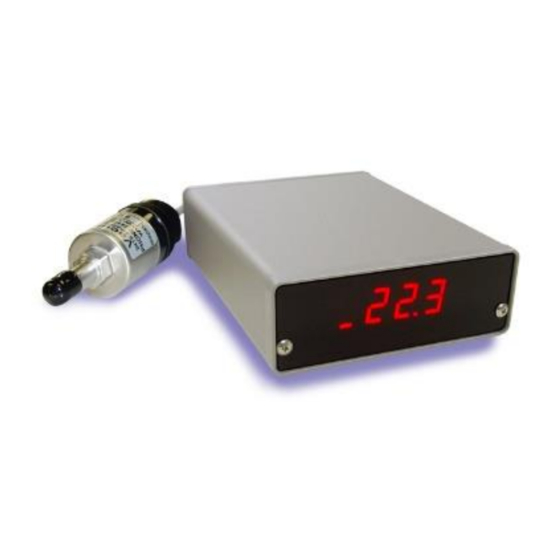DigiVac 2L760 Manuel d'instruction - Page 8
Parcourez en ligne ou téléchargez le pdf Manuel d'instruction pour {nom_de_la_catégorie} DigiVac 2L760. DigiVac 2L760 10 pages. Digital vacuum gauge

6.0 SERVICING - GAUGE TUBE CLEANING.
In some cases, a gauge tube may become contaminated with oil or other foreign matter. Once contamination
occurs, the sensor needs to be replaced. Please send the controller back to DIGIVAC for mating gauge tube
replacement.
6.1 FACTORY REPAIR AND CALIBRATION.
The vacuum gauge assembly is designed to provide years of trouble-free service, and the liberal internal use of
plug-in components makes it easily repairable. Field servicing of the unit is not recommended. The accuracy of
calibration is dependent on the quality of the gauge tube, accuracy of calibration is difficult to achieve in a field
setting. Each DIGIVAC vacuum gauge controller is calibrated to the particular vacuum gauge sensor that is
shipped with the unit.
In the event the user must recalibrate the instrument, the following procedures are suggested.
A. Before re-calibrating the instrument, it should be ascertained that the instrument is in fact incorrect. In
many cases, the problem will be with a tube that is contaminateded, or a system that is operating
improperly. It is recommended that a spare tube be kept on hand and stored in a clean, dry place. Then,
in cases of suspect readings, the tube should be changed before proceeding further.
B. Calibration instructions:
1. Put gauge on a manifold with a standard such as a capacitance manometer, and set manifold
pressure to 750 Torr or 1000 mbar
2. Adjust "ATM" potentiometer to 750 Torr (for Torr units) (or 1000 mbar) (matching standard)
3. Set manifold to 5 Torr and adjust "vac" potentiometer so it reads 5 Torr +/- 0.2 Torr. (for mbar
installations, set at 6.4 mbar +/- 0.2 mbar)
7.0 NOTES ON CALIBRATION.
The DIGIVAC is calibrated in nitrogen. This device can measure any clean dry gas and retain calibration.
Note that isolated transducers like capacitance manometers are independent of gas type or moisture content.
8.0 UNDERSTANDING TORR.
The 2L760 and many similar instruments are calibrated in microns or "millitorr." Microns are not really a measure
of vacuum at all, but rather of absolute pressure. It will be recalled that the pressure of the atmosphere is
14.696 or approximately 14.7 pounds per square inch at sea level. This pressure is due to the weight of all of the
air in the earth's atmosphere above any particular square inch. This 14.696 psi is equivalent to the pressure
produced by a mercury column of approximately 29.92 inches high or .76 meters (about 3/4 of a yard) or 760
millimeters of mercury. Atmospheric pressure varies greatly with altitude. It decreases approximately 1 inch of
mercury per thousand feet of altitude. It also varies widely with local weather conditions. (Variations of one half
inch in a single day are common.) The word vacuum means pressure lower than atmospheric or "suction," but,
in describing negative pressure, the atmosphere is only a satisfactory reference if we are dealing with values of
vacuum down to about 27 inches of mercury. Below that, it is much more useful to talk in terms of absolute
pressure, starting from absolute zero. The 2L760 and all similar instruments measure negative pressure below
27" of mercury.
One TORR, a commonly used unit, is an absolute pressure of one millimeter of mercury. A millitorr is equal to
one thousandth of a TORR. A MICRON is the same as a millitorr.
DIGIVAC 2L760 Instruction Manual Page 8
